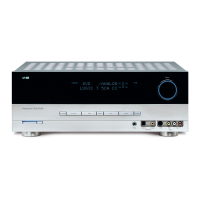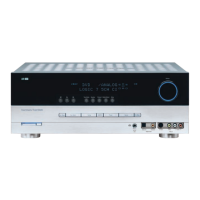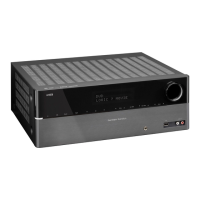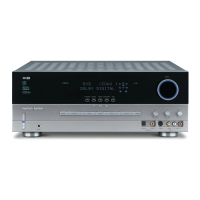Delay times are adjustable for all surround modes.
Although all channels will appear on screen with the
default or previously entered distances, the menu sys-
t
em will only allow you to adjust the settings for those
c
hannels which are actually used by the current sur-
round mode. For example, when you are listening to
music CDs using the CD input in DSP Surround Off
mode, you may adjust the delay settings for the front
l
eft, front right and subwoofer channels only. The cur-
sor will simply skip the other channels as you navigate
through the menu. Therefore, the first time you adjust
the delay settings, it is recommended that you select a
5
.1-, 6.1- or 7.1-channel surround mode, depending
on the number of speakers in your system. For the
purposes of setting the delay distances, the Logic 7
modes allow access to the settings for all channels
without requiring that you play a source.
When your system includes a surround back speaker,
delay distances should be entered twice for this
speaker, once for the surround back left channel,
and again for the surround back right channel. This
enables the mixing circuit that combines the signals
for these channels when a 7.1-channel surround
mode is in use to output the information correctly.
To set the delay time for a specific input, the
DELAY ADJUST submenu (Figure 10) should
be visible on your on-screen display. If it is not, press
the
OSD Button v to bring up the MASTER
MENU
, and press the
¤
Button n until the
on-screen
›
cursor is pointing at the MANUAL
SETUP
line. Press the Set Button p to enter
the
MANUAL SETUP submenu, and then scroll
down using the
¤ Button n until the › cursor
is pointing to the
DELAY ADJUST line. Press
the
Set Button p again, and the DELAY
ADJUST
submenu will appear (see Figure 10).
Figure 10
Once the DELAY ADJUST menu is on your
screen, note that the default setting to enter the dis
-
tances from the speakers to the listening position is in
feet. If your measurements are in feet, proceed to the
next step; if your measurements are made in meters,
press the
¤
Button n until the on-screen
›
cursor
is at the
UNIT line on the menu. Then, press the
‹
/
›
Buttons o so that METER is highlighted.
When the change in measurement units is made,
press the
⁄
/
¤
Buttons n to return the
›
cursor
to the
FL position.
W
ith the on-screen
›
c
ursor pointing to
F
L
,
press
the
‹
/
›
Buttons o until the distance from the
front left speaker to the preferred listening position
is entered. Next, press the
¤
Button n to move
t
he cursor to the
C
ENTER
l
ine and use the
‹
/
›
Buttons o again to enter the distance from the
center speaker to the listening position. Continue in
this fashion to enter the distance from the listening
position to each of the front right
(FR), surround
r
ight
(
SR)
,
surround back right
(
SBR)
,
sur-
round back left
(SBL), surround left (SL) and
subwoofer
(SUB) speakers. Remember that the
SBL and SBR adjustments will only be needed
when you have surround back speakers installed.
When the speaker-to-listening-position distance has
been entered for all active speaker positions, press the
⁄
/
¤
Buttons n until the on-screen cursor is next
to
BACK TO MANUAL SETUP and press
the
Set Button p.
If you wish to reset the delay settings to their factory
defaults at any time, use the
⁄
/
¤
Buttons n so
that the cursor is pointing to
DELAY RESET
and then press the
‹
/
›
Buttons o so that OFF
appears. The factory settings shown in Figure 10 will
then be restored.
The delay settings may be changed at any time
directly from the remote control by pressing the
Delay Button . CENTER DELAY will
appear in the
Lower Display Line ı, but you
may press the
⁄
/
¤
Buttons n to select any
of the speaker groups.
Output Level
Adjustment
Output level adjustment is a key part of the configura-
tion of any surround sound product. It is particularly
important for a digital receiver such as the AVR 140,
as correct outputs ensure that you hear soundtracks
with the proper directionality and intensity
.
IMPORTANT NOTES:
•
Listeners are often confused about the operation
of the surround channels. While some assume that
sound should always be coming from each speaker
,
most of the time there will be little or no sound in
the surround channels. This is because they are
only used when a movie director or sound mixer
specifically places sound there to create ambience
or a special effect, or to continue action from the
front of the room to the rear. Once the output
levels are properly set,
it is normal for surround
speakers to operate only occasionally. Artificially
increasing the volume to the rear speakers may
destroy the illusion of an enveloping sound field
that duplicates the way
you hear sound in a movie
theater or concert hall.
•
When the AVR 140 is configured for 6.1-channel
operation
using a single surround back speaker
,
the
output level adjustments will still provide an adjustment
for separate surround back left and surround back right
positions even though your system has only one sur-
r
ound back speaker. This means that the Surround
B
ack channel will seem to appear twice, and in 6.1
operation this is normal. The separate SBL/SBR adjust-
ments for 6.1 operation are needed to optimize the
balance between the two discrete channels within the
A
VR as they are mixed for output to a single speaker.
Before beginning the output level adjustment process,
make sure all speaker connections have been properly
made. The system volume should be set to the level
that you will use during a typical listening session.
Using the Full-OSD System
Follow these steps while seated in the listening posi-
tion that will be used most often:
1. Adjust the volume so that it is at
-15dB,as
shown in the on-screen display or
Lower
Display Line
ı.
2. Make certain that all speaker positions have been
properly configured for their
LARGE or
SMALL settings (as outlined above).
3. Output level adjustment is most easily done
through the
CHANNEL ADJUST sub-
menu (Figure 11). If you are already at the
MASTER MENU, press the
¤
Button n
until the on-screen
›
cursor is next to the
MANUAL SETUP line. Press the Set
Button
p to enter the MANUAL SETUP
submenu, and then scroll down using the
¤ Button n until the › cursor is pointing
to the
CHANNEL ADJUST line.
Press the
Set Button p again, and the
CHANNEL
ADJUST
submenu will
appear (see Figure 11).
Figure 11
When the CHANNEL ADJUST submenu
first appears, the test tone is off. If desired, you
may immediately use the
¤ Button n to
select any channel for adjustment using an exter-
nal source, such as a test disc, to judge the out-
put levels. With the
› cursor pointing to the
channel to be adjusted, press the
‹/› Buttons
o to raise or lower the output level. However,
before proceeding with any manual adjustment
we recommend that you first use the
A
VR’
s inter
-
* CHANNEL ADJUST *
FL : 0dB SBR: 0dB
CEN: 0dB SBL: 0dB
FR : 0dB SL : 0dB
SR : 0dB SUB: 0dB
CHANNEL RESET:OFF
TEST TONE SEQ:AUTO
TESY TONE :OFF
BACK TO MANUAL SETUP
33
34
35
36
37
38
39
40
41
48
49
46
47
44
45
42
43
3
8
39
40
41
31
32
30
28
29
25
26
27
28
29
30
24
23
22
2
1
20
31
37
36
35
34
33
32
3
1
3
7
3
6
35
34
33
32
4
8
49
50
51
4
7
4
6
45
44
43
42
* DELAY ADJUST *
FL : 10FT SBR: 10FT
CEN: 10FT SBL: 10FT
FR : 10FT SL : 10FT
SR : 10FT SUB: 10FT
DELAY RESET:OFF
UNIT: FEET
BACK TO MANUAL SETUP
SYSTEM CONFIGURATION 23SYSTEM CONFIGURATION 23
SYSTEM CONFIGURATION
AVR 140 OM 3/29/06 3:45 PM Page 23
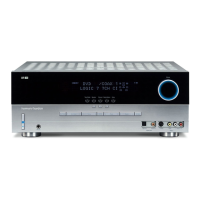
